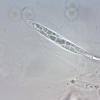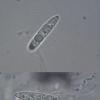
18-12-2025 17:23
 Bruno Coué
Bruno Coué
Bonjour,je serais heureux d'avoir votre avis sur c

18-12-2025 21:17
Pol DebaenstThe identification took me to Byssonectria deformi

18-12-2025 18:07
Margot en Geert VullingsThese plumes were found on rotten wood.They strong

17-12-2025 18:35
 Michel Hairaud
Michel Hairaud
Bonjour à tous/Hi to everyone I am passing along

15-12-2025 15:48
 Danny Newman
Danny Newman
Melanospora cf. lagenaria on old, rotting, fallen

15-12-2025 15:54
 Johan Boonefaes
Johan Boonefaes
Unknown anamorph found on the ground in coastal sa

15-12-2025 21:11
 Hardware Tony
Hardware Tony
Small clavate hairs, negative croziers and IKI bb

15-12-2025 07:09
 Danny Newman
Danny Newman
indet. Rutstroemiaceae sp. on unk. fallen leavesMc
Perithecia are black, superficial, ca 250 µm diam, with a more or less smooth surface. Some have a small inconspicuous papilla.
Asci are cylindrical-clavate, gradually narrowed to base, 80-90 x 8-9 µm. They are 8-spored, irregularly biseriate. The apical ring is visible as 2 small dots (IKI negative).
Paraphyses are abundant.
Spores are hyaline, straight or slightly curved, 17-22 x 3.5-5 µm. They are 0-septate, though sometimes appearing 1-septate in KOH. In water large OBs are present.
I have struggled to identify this specimen. I've wondered about something in the Lasiosphaeriaceae or Trichosphaeriaceae but haven't got any further than that. Using Munk the closest match seems to be Trichosphaeria melanostigmoides but I'm not convinced this is correct, e.g. the spore shape doesn't look quite right.
I'd be very grateful for any help.
Marcus

it looks like a Chaetosphaeria, a genus where a safe identification at species level most often requires the anamorph. Apparently the anamorph is not visible on your first photo. Maybe you can find it around the colony.
Good luck,
Jacques
Jacques
Thanks for your suggestion. I'd ruled out Chaetosphaeria because the spores of my specimen appear to be consistently without septa - possibly the spores aren't fully mature? I didn't notice an anamorph associated with the perithecia but I'll have another look.
Marcus
Hi friends,
Apparently ascospores are uniseptate. You can see that feature with observation in Melzer.
Alain
Some spores appear to be 1-septate in KOH and in MLZ but I wasn't certain. It looked as if this might just be an artefact caused by the way in which the oil bodies had dispersed. I will take another look.
Marcus
I've looked at spores in Melzers and I believe they lack septa at first, but become 1-septate in the ascus.
I also found an anamorph associated with some of the perithecia. It has brown, unbranched, septate conidiophores, ca 125-160 x 4-5 µm. Conidia are borne terminally on short, slender hyaline stalks. They are obovoid; 16-19 x 11-14 µm; 2-septate, with a small hyaline basal cell and 2 large brown cells.
The anamorph appears to be a Brachysporium, either B. obovatum or B. britannicum. This would indicate that the teleomorph belongs to the genus Cryptadelphia, which seems a reasonable fit. Using the 2004 paper by Reblova & Seifert, C. obovata is a possibility. However, the ascospores of my specimen are generally longer and narrower than the description of C. obovata, and the colour and width of the conidia don't seem to fit B. obovatum (the anamorph of C.obovata). The anamorph of my specimen seems to fit the description of B. britannicum – Reblova & Seifert state that teleomorphs for B. britannicum have not been discovered.
So perhaps I'm making progress towards an identification. Any views would be welcome.
Marcus

Best wishes
Chris

this is a nice and conclusive investigation.I will keep Cryptadelphia in mind!
As to the use of Melzer to see the septa when they are blurred by spore contents, I sugest to just keep the slide overnight and let the reagent clear off the contents and show even the most delicate septa.
Cheers,
Jacques
Chris & Jacques
Thank you both for your help.
Marcus








